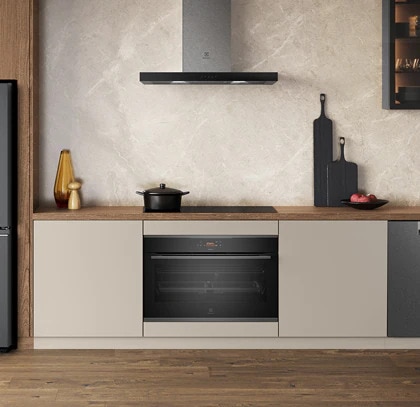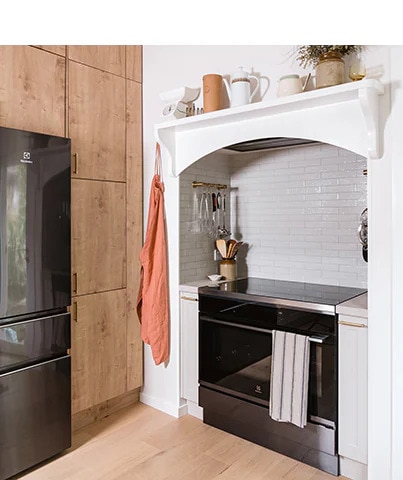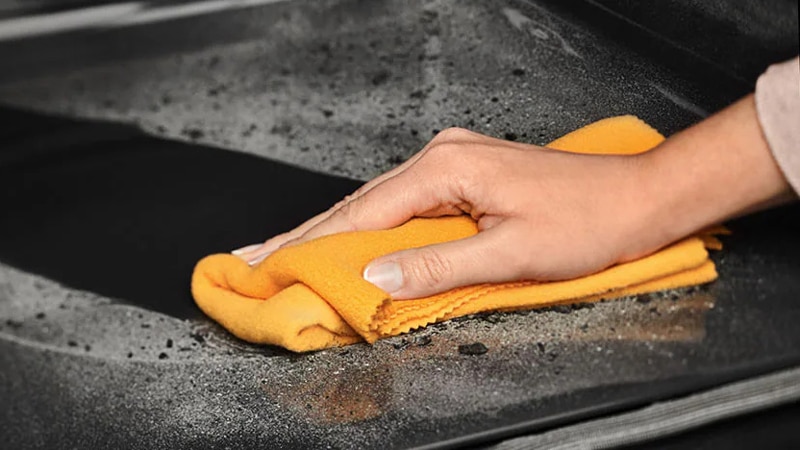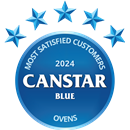1. Oven types
There are many types of ovens available for you and it can be difficult to select the right one. Our buying guide will help you identify the right oven for your needs, whether it be a gas, electric, freestanding, steam, pyrolytic, oven-microwave combo or compact ovens or double ovens.
2. Fuel Source

Electric oven
Electric ovens are simpler to install than their gas counterparts, and can easily be fitted simply by plugging into existing power supply - though most require professional fitting. One of the benefits of an electric oven is that it usually comes with a lower price tag, and in terms of design, an electric cooktop is able to have a sleek, glass finish that adds sophistication to your kitchen and can be easily wiped down after use without having to dismantle burners or hotplates for cleaning.

Dual fuel
An increasingly popular product is the hybrid gas/electric oven, which features a gas cooktop on top of an electric oven. This type of freestanding cooker has the advantage of instant stovetop heat coupled with simple, electricity-fuelled baking capacity.

3. Kitchen layout and design
One of the most important factors to consider in your oven purchase is how you’d like your kitchen configured to best suit your family. Ideally, keeping your cooktop, fridge and sink within easy manoeuvring distance from each other is a good rule of thumb, but other considerations must also come into play.
For those with young children, a wall oven can be an excellent option as it is safer out of reach of little hands, and for frequent bakers, the height of a wall oven can definitely save your back! Alternatively, those looking to capitalise on space may prefer an all-in-one freestanding oven and cooktop which allows more cupboard space and a compact, simple option.
For those with young children, a wall oven can be an excellent option as it is safer out of reach of little hands, and for frequent bakers, the height of a wall oven can definitely save your back! Alternatively, those looking to capitalise on space may prefer an all-in-one freestanding oven and cooktop which allows more cupboard space and a compact, simple option.
Image courtesy of Oak & Orange
4. Energy efficiency
Your oven is a surprisingly large contributor to your average yearly power bill. With an average family of four pays nearly $2000 a year in energy costs, and the average cost of running an oven within that is between $400-$800 a year - or between a quarter or a third of your total bill*. For this reason, focusing on how to choose, use and maintain your oven sustainably has never been more important. In order to maximise oven energy efficiency, consider the following tips:
*According to the Electricity wizard
5. Maintenance and cleaning
How to clean an oven depends largely on the model you have purchased. For example, our pyrolytic feature heats baked-on grease and food to a temperature high enough to turn it into ash, meaning there’s no need to scrub and scour - simply wipe up the ash when it’s finished.
It’s important to remember to remove the telescopic door runners before using this feature, but apart from that, it’s the easiest way to maintain your oven’s cleanliness. For other models, maintenance includes removing and wiping drawers and racks, and regularly wiping down the inner walls and glass of the door to prevent splatter buildup. Ensure you check the gaskets and elements periodically to preserve optimal function.
It’s important to remember to remove the telescopic door runners before using this feature, but apart from that, it’s the easiest way to maintain your oven’s cleanliness. For other models, maintenance includes removing and wiping drawers and racks, and regularly wiping down the inner walls and glass of the door to prevent splatter buildup. Ensure you check the gaskets and elements periodically to preserve optimal function.

6. Warranty and service
Our ovens come with a 24-month warranty, and servicing is available through our list of registered providers. To find the address of your nearest authorised service centre in Australia please call 13 13 49 or email customercare@electrolux.com.au
7. Top FAQs
-
What is a steam oven?
Rather than using the hot air traditionally used to cook food, a steam oven uses hot air combined with steam throughout the cooking process, cooking your food 30% quicker and creating a whole new range of options in the kitchen.
-
What is a pyrolytic oven?
Pyrolytic ovens, also known as self-cleaning ovens, heat baked-on food and splatters to high temperatures until they are turned to ash, making them much simpler and easier to wipe off - no elbow-grease necessary!
-
How often should you replace your oven?
The general lifespan of an oven is between 10 and 15 years. With proper maintenance and cleaning, you’ll ensure the longevity and efficiency of your appliance.
-
Is it worth fixing an oven?
Depending on the issue and the warranty period on your appliance, it is worth weighing up the cost of service and or repair with the cost of replacement. This will vary greatly depending on individual circumstances, and the best way forward is to have the issue assessed by one of our registered service technicians. To find the address of your nearest authorised service centre in Australia.
PLEASE CALL 13 13 49
OR EMAIL customercare@electrolux.com.au -
What does an "E" error code mean?
If the display shows an 'E' and a number, there is an error in the appliance. Deactivate and activate the appliance and review the user manual to identify the correct error. If the problem continues, contact the Authorised Service Centre.






















